Silicon Electrodeposition for Microelectronics and Distributed Energy: A Mini-Review
Abstract
:1. Introduction
2. Molten Salts for Silicon Electrodeposition
2.1. Choice of the Molten Salt
- -
- purity and low chemical activity of salts in relation to the materials of the electrolyzer, and the possibility of their purification;
- -
- stability of the concentration and composition of silicon-containing electroactive ions, which can be ensured by the high complexing ability of silicon ions;
- -
- stability of elemental silicon in melts with Si4+ ions;
- -
- rate of silicon electrodeposition, provided by a consistently high concentration of electroactive silicon ions, in consideration of the laws of their electroreduction;
- -
- high solubility of salts in aqueous solutions or high vapor pressure of salts during high-temperature distillation.
2.2. Basics of the Silicon Electrodeposition
2.3. Results of the Silicon Electrodeposition
3. Electrolytic Silicon for Microelectronics
4. Electrolytic Silicon for Lithium-Ion Current Sources
5. Electrolytic Silicon in Solar Cells
6. Conclusions
Funding
Institutional Review Board Statement
Informed Consent Statement
Data Availability Statement
Conflicts of Interest
References
- Bhalothia, D.; Hsiung, W.; Yang, S.; Yan, C.; Chen, P.; Lin, T.; Wu, S.; Chen, P.; Wang, K.; Lin, M.; et al. Submillisecond Laser Annealing Induced Surface and Subsurface Restructuring of Cu–Ni–Pd Trimetallic Nanocatalyst Promotes Thermal CO2 Reduction. ACS Appl. Energy Mater. 2021, 4, 14043–14058. [Google Scholar] [CrossRef]
- Yu, J.; Zhang, H.; Olsson, E.; Yu, T.; Liu, Z.; Zhang, S.; Huang, X.; Li, W.; Cai, Q. A Novel Amorphous P4SSe2 Compound as an Advanced Anode for Sodium-Ion Batteries in Ether-Based Electrolytes. J. Mater. Chem. A 2021, 9, 12019–12028. [Google Scholar] [CrossRef]
- Huang, T.; Bhalothia, D.; Dai, S.; Yan, C.; Wang, K.; Chen, T. Bifunctional Pt–SnOx Nanorods for Enhanced Oxygen Reduction and Hydrogen Evolution Reactions. Sustain. Energy Fuels 2021, 5, 2960–2971. [Google Scholar] [CrossRef]
- Wang, F.; Li, P.; Li, W.; Wang, D. Electrochemical Synthesis of Multidimensional Nanostructured Silicon as a Negative Electrode Material for Lithium-Ion Battery. ACS Nano 2022, 16, 7689–7700. [Google Scholar] [CrossRef]
- Islam, M.M.; Said, H.; Hamzaoui, A.H.; Mnif, A.; Sakurai, T.; Fukata, N.; Akimoto, K. Study of Structural and Optical Properties of Electrodeposited Silicon Films on Graphite Substrates. Nanomaterials 2022, 12, 363. [Google Scholar] [CrossRef]
- Kulova, T.L. New Electrode Materials for Lithium–Ion Batteries (Review). Russ. J. Electrochem. 2013, 49, 1–25. [Google Scholar] [CrossRef]
- Gavrilin, I.M.; Grevtsov, N.L.; Pavlikov, A.V.; Dronov, A.A.; Chubenko, E.B.; Bondarenko, V.P.; Gavrilov, S.A. A New Approach for Producing of Film Structures Based on Si1−xGex. Mater. Lett. 2022, 313, 131802. [Google Scholar] [CrossRef]
- Anfimov, I.M.; Kobeleva, S.P.; Malinkovich, M.D.; Shchemerov, I.V.; Toporova, O.V.; Parkhomenko, Y.N. Mechanisms of Electroconductivity in Silicon–Carbon Nanocomposites with Nanosized Tungsten Inclusions within a Temperature Range of 20–200 °C. Russ. Microelectron. 2013, 42, 488–491. [Google Scholar] [CrossRef]
- O'Mara, W.C.; Haber, R.B.; Hunt, L.P. Handbook of Semiconductor Silicon Technology; Noyes Publications: Park Ridge, NJ, USA, 1990; ISBN 9780815517702. [Google Scholar]
- Malyshev, V.V.; Kushkhov, H.B.; Shapoval, V.I. High-Temperature Electrochemical Synthesis of Carbides, Silicides and Borides of VI-Group Metals in Ionic Melts. J. Appl. Electrochem. 2002, 32, 573–579. [Google Scholar] [CrossRef]
- Medjahed, S.; Kheloufi, A.; Bobocioiu, E.; Kefaifi, A.; Kerkar, F.; Lebbou, K. Quartz Ore Beneficiation by Reverse Flotation for Silicon Production. Silicon 2022, 14, 87–97. [Google Scholar] [CrossRef]
- Wu, J.J.; Chen, Z.; Ma, W.; Dai, Y. Thermodynamic Estimation of Silicon Tetrachloride to Trichlorosilane by a Low Temperature Hydrogenation Technique. Silicon 2017, 9, 69–75. [Google Scholar] [CrossRef]
- Cohen, U. Some Prospective Applications of Silicon Electrodeposition from Molten Fluorides to Solar Cell Fabrication. J. Electron. Mater. 1977, 6, 607–643. [Google Scholar] [CrossRef]
- Rao, G.M.; Elwell, D.; Feigelson, R.S. Electrodeposition of silicon onto graphite. J. Electrochem. Soc. 1981, 128, 1708–1711. [Google Scholar] [CrossRef]
- Bieber, A.L.; Massot, L.; Gibilaro, M.; Cassayre, L.; Taxil, P.; Chamelot, P. Silicon Electrodeposition in Molten Fluorides. Electrochim. Acta 2012, 62, 282–289. [Google Scholar] [CrossRef] [Green Version]
- Kuznetsova, S.V.; Dolmatov, V.S.; Kuznetsov, S.A. Voltammetric Study of Electroreduction of Silicon Complexes in a Chloride–Fluoride Melt. Russ. J. Electrochem. 2009, 45, 742–748. [Google Scholar] [CrossRef]
- Vasilév, Y.B.; Verezub, N.A.; Mezhennyi, M.V.; Prosolovich, V.S.; Prostomolotov, A.I.; Reznik, V.Y. Features of Defect Formation under the Thermal Treatment of Dislocation−Free Single−Crystal Large−Diameter Silicon Wafers with the Specified Distribution of Oxygen−Containing Gettering Centers in the Bulk. Russ. Microelectron. 2013, 42, 467–476. [Google Scholar] [CrossRef]
- Plugotarenko, N.K.; Myasoedova, T.N.; Grigoryev, M.N.; Mikhailova, T.S. Electrochemical Deposition of Silicon-Carbon Films: A Study on the Nucleation and Growth Mechanism. Nanomaterials 2019, 9, 1754. [Google Scholar] [CrossRef] [Green Version]
- Downes, N.; Cheek, Q.; Maldonado, S. Electroreduction of Perchlorinated Silanes for Si Electrodeposition. J. Electrochem. Soc. 2021, 168, 022503. [Google Scholar] [CrossRef]
- Walcarius, A.; Sibottier, E.; Etienne, M.; Ghanbaja, J. Electrochemically Assisted Self-Assembly of Mesoporous Silica ThinFilms. Nat. Mater. 2007, 6, 602–608. [Google Scholar] [CrossRef]
- Nguyen, N.T.; Renaud, A.; Wilmet, M.; Dumait, N.; Paofai, S.; Benjamin, D.; Whnagwui, C.; Ohashi, N.; Cordier, S.; Grasset, F.; et al. New Ultra-Violet and Near-Infrared Blocking Filters for Energy Saving Applications: Fabrication of Tantalum Metal Atom Cluster-Based Nanocomposite Thin Films by Electrophoretic Deposition. J. Mater. Chem. C 2017, 5, 10477–10484. [Google Scholar] [CrossRef]
- Sciortino, F.; Rydzek, G.; Grasset, F.; Kahn, M.L.; Hill, J.P.; Chevance, S.; Gauffre, F.; Ariga, K. Electro-Click Construction of Hybrid Nanocapsule Films with Triggered Delivery Properties. Phys. Chem. Chem. Phys. 2018, 20, 2761–2770. [Google Scholar] [CrossRef] [PubMed]
- Palma-Cando, A.; Rendón-Enríquez, I.; Tausch, M.; Scherf, U. Thin Functional Polymer Films by Electropolymerization. Nanomaterials 2019, 9, 1125. [Google Scholar] [CrossRef] [PubMed] [Green Version]
- Chen, W.; Truong, T.N.; Nguyen, H.T.; Samundsett, C.; Phang, S.P.; MacDonald, D.; Cuevas, A.; Zhou, L.; Wan, Y.; Yan, D. Influence of PECVD Deposition Temperature on Phosphorus Doped Poly-Silicon Passivating Contacts. Solar Energy Mater. Sol. Cells 2020, 206, 110348. [Google Scholar] [CrossRef]
- Available online: https://www.scopus.com (accessed on 15 October 2022).
- Juzeliunas, E.; Fray, D.J. Silicon Electrochemistry in Molten Salts. Chem. Rev. 2020, 120, 1690–1709. [Google Scholar] [CrossRef] [PubMed]
- Dong, Y.; Slade, T.; Stolt, M.J.; Li, L.; Girard, S.N.; Mai, L.; Jin, S. Low-Temperature Molten-Salt Production of Silicon Nanowires by the Electrochemical Reduction of CaSiO3. Angew. Chem. 2017, 129, 14645–14649. [Google Scholar] [CrossRef]
- Zou, X.; Ji, L.; Yang, X.; Lim, T.; Yu, E.T.; Bard, A.J. Electrochemical Formation of a p−n Junction on Thin Film Silicon Deposited in Molten Salt. J. Amer. Chem. Soc. 2017, 139, 16060–16063. [Google Scholar] [CrossRef] [PubMed]
- Yasuda, K.; Maeda, K.; Hagiwara, R.; Homma, T.; Nohira, T. Silicon Electrodeposition in a Water-Soluble KF–KCl Molten Salt: Utilization of SiCl4 as Si Source. J. Electrochem. Soc. 2017, 164, D67–D71. [Google Scholar] [CrossRef]
- Zaykov, Y.P.; Zhuk, S.I.; Isakov, A.V.; Grishenkova, O.V.; Isaev, V.A. Electrochemical Nucleation and Growth of Silicon in the KF–KCl–K2SiF6 Melt. J. Solid State Electrochem. 2015, 19, 1341–1345. [Google Scholar] [CrossRef]
- Chemezov, O.V.; Isakov, A.V.; Apisarov, A.P.; Brezhestovsky, M.S.; Bushkova, O.V.; Batalov, N.N.; Zaikov, Y.P.; Shashkin, A.P. Electrolytic Production of Silicon Nanofibers from the KCl–KF–K2SiF6–SiO2 Melt for Composite Anodes of Lithium-Ion Batteries. Electrochim. Energetics 2013, 13, 201–204. [Google Scholar] [CrossRef]
- Ustinova, Y.; Pavlenko, O.; Gevel, T.; Zhuk, S.; Suzdaltsev, A.; Zaikov, Y. Electrodeposition of Silicon from the Low-Melting LiCl–KCl–CsCl–K2SiF6 Electrolytes. J. Electrochem. Soc. 2022, 169, 032506. [Google Scholar] [CrossRef]
- Gevel, T.; Zhuk, S.; Leonova, N.; Leonova, A.; Trofimov, A.; Suzdaltsev, A.; Zaikov, Y. Electrochemical Synthesis of Nano-Sized Silicon from KCl–K2SiF6 Melts for Powerful Lithium-Ion Batteries. Appl. Sci. 2021, 11, 10927. [Google Scholar] [CrossRef]
- Trofimov, A.A.; Leonova, A.M.; Leonova, N.M.; Gevel, T.A. Electrodeposition of Silicon from Molten KCl–K2SiF6 for Lithium-Ion Batteries. J. Electrochem. Soc. 2022, 169, 020537. [Google Scholar] [CrossRef]
- Gevel, T.A.; Zhuk, S.I.; Leonova, N.M.; Leonova, A.M.; Suzdaltsev, A.V.; Zaikov, Y.P. Electrodeposition of Silicon from the KCl–CsCl–K2SiF6 Melt. Russ. Met. (Metally) 2022, 2022, 958–964. [Google Scholar] [CrossRef]
- Pavlenko, O.B.; Ustinova, Y.A.; Zhuk, S.I.; Suzdaltsev, A.V.; Zaikov, Y.P. Silicon Electrodeposition from Low-Melting LiCl-KCl-CsCl Melts. Russ. Met. (Metally) 2022, 2022, 818–824. [Google Scholar] [CrossRef]
- Nikolaev, A.Y.; Mullabaev, A.R.; Suzdaltsev, A.V.; Kovrov, V.A.; Kholkina, A.S.; Shishkin, V.Y.; Zaikov, Y.P. Purification of Alkali-Metal Chlorides by Zone Recrystallization for the Use in Pyrochemical Processing of Spent Nuclear Fuel. Atomic Energy 2022, 131, 195–201. [Google Scholar] [CrossRef]
- Laptev, M.V.; Isakov, A.V.; Grishenkova, O.V.; Vorob'ev, A.S.; Khudorozhkova, A.O.; Akashev, L.A.; Zaikov, Y.P. Electrodeposition of Thin Silicon Films from the KF–KCl–KI–K2SiF6 Melt. J. Electrochem. Soc. 2020, 167, 042506. [Google Scholar] [CrossRef]
- Laptev, M.V.; Khudorozhkova, A.O.; Isakov, A.V.; Grishenkova, O.V.; Zhuk, S.I.; Zaikov, Y.P. Electrodeposition of Aluminum-Doped Thin Silicon Films from a KF–KCl–KI–K2SiF6–AlF3 Melt. J. Serb. Chem. Soc. 2021, 86, 1075–1087. [Google Scholar] [CrossRef]
- Chen, X.; Gerasopoulos, K.; Guo, J.; Brown, A.; Wang, C.; Ghodssi, R.; Culver, J.N. A Patterned 3D Silicon Anode Fabricated by Electrodeposition on a Virus-Structured Current Collector. Adv. Funct. Mater. 2011, 21, 380–387. [Google Scholar] [CrossRef]
- Galashev, A.Y.; Suzdaltsev, A.V.; Ivanichkina, K.A. Design of the High Performance Microbattery with Silicene Anode. Mater. Sci. Eng. B 2020, 261, 114718. [Google Scholar] [CrossRef]
- Salah, M.; Hall, C.; Murphy, P.; Francis, C.; Kerr, R.; Stoehr, B.; Rudd, S.; Fabretto, M. Doped and Reactive Silicon Thin Film Anodes for Lithium Ion Batteries: A review. J. Power Sources 2021, 506, 230194. [Google Scholar] [CrossRef]
- Hou, Y.; Yang, Y.; Meng, W.; Lei, B.; Ren, M.; Yang, X.; Wang, Y.; Zhao, D. Core-Shell Structured Si@Cu Nanoparticles Encapsulated in Carbon Cages as High-Performance Lithium-Ion Battery Anodes. J. Alloys Compd. 2021, 874, 159988. [Google Scholar] [CrossRef]
- Zou, X.; Ji, L.; Ge, J.; Sadoway, D.R.; Yu, E.T.; Bard, A.J. Electrodeposition of Crystalline Silicon Films from Silicon Dioxide for Low-Cost Photovoltaic Applications. Nat. Commun. 2019, 10, 5772. [Google Scholar] [CrossRef] [PubMed] [Green Version]
- Peng, J.; Yin, H.; Zhao, J.; Yang, X.; Bard, A.J.; Sadoway, D.R. Liquid-Tin-Assisted Molten Salt Electrodeposition of Photoresponsive n-Type Silicon Films. Adv. Funct. Mater. 2018, 28, 1703551. [Google Scholar] [CrossRef]
- Yasuda, K.; Kato, T.; Norikawa, Y.; Nohira, T. Silicon Electrodeposition in a Water-Soluble KF–KCl Molten Salt: Properties of Si Films on Graphite Substrates. J. Electrochem. Soc. 2021, 168, 112502. [Google Scholar] [CrossRef]


| Electrolyte [Refs] | Si Source | T (°C), Current Density (A cm−2) | Results | Images | ||
|---|---|---|---|---|---|---|
| Mixtures of KF, NaF, LiF, BaF2, CaF2 [13,14,15] | Si, K2SiF6, SiO2 | 550–1500, 0.05–1 | Compact deposits up to 1 mm, micro-sized dendrites, fibers |  | 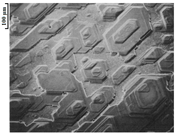 |  |
| CaCl2–CaO [26,27,28] | SiO2, CaSiO3 | 800–860, 0.01–0.05 | Micro- and nano-sized fibers, films on quartz, tubes | 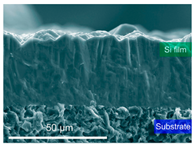 |  | 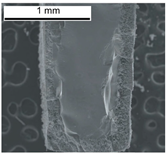 |
| KF–KCl [29,30,31] | Si, K2SiF6, SiO2, SiCl4 | 700–750, 0.05–0.2 | Micro- and nano-sized fibers, films, dendrites | 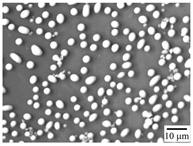 | 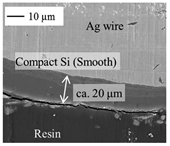 | 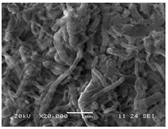 |
| Mixtures of KCl, CsCl, LiCl with K2SiF6 [32,33,34,35,36] | Si, K2SiF6, SiO2 | 350–790, 0.05–0.4 | Micro- and nano-sized fibers, needles, pipes, films | 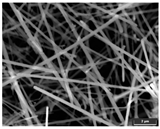 |  |  |
| KI–KF–KCl [38,39] | Si, K2SiF6 | 700–750, 0.05–0.2 | Micro- and nano-sized fibers, films | 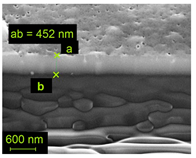 |  |  |
| Ionic liquids, organic electrolytes [18,19,40] | SiCl4, chloro-silanes | 25–80, 0.0001–0.005 | Micro- and nano-sized fibers, films |  | 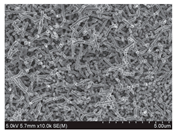 | 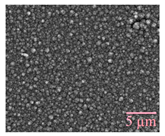 |
Publisher’s Note: MDPI stays neutral with regard to jurisdictional claims in published maps and institutional affiliations. |
© 2022 by the author. Licensee MDPI, Basel, Switzerland. This article is an open access article distributed under the terms and conditions of the Creative Commons Attribution (CC BY) license (https://creativecommons.org/licenses/by/4.0/).
Share and Cite
Suzdaltsev, A. Silicon Electrodeposition for Microelectronics and Distributed Energy: A Mini-Review. Electrochem 2022, 3, 760-768. https://doi.org/10.3390/electrochem3040050
Suzdaltsev A. Silicon Electrodeposition for Microelectronics and Distributed Energy: A Mini-Review. Electrochem. 2022; 3(4):760-768. https://doi.org/10.3390/electrochem3040050
Chicago/Turabian StyleSuzdaltsev, Andrey. 2022. "Silicon Electrodeposition for Microelectronics and Distributed Energy: A Mini-Review" Electrochem 3, no. 4: 760-768. https://doi.org/10.3390/electrochem3040050
APA StyleSuzdaltsev, A. (2022). Silicon Electrodeposition for Microelectronics and Distributed Energy: A Mini-Review. Electrochem, 3(4), 760-768. https://doi.org/10.3390/electrochem3040050






